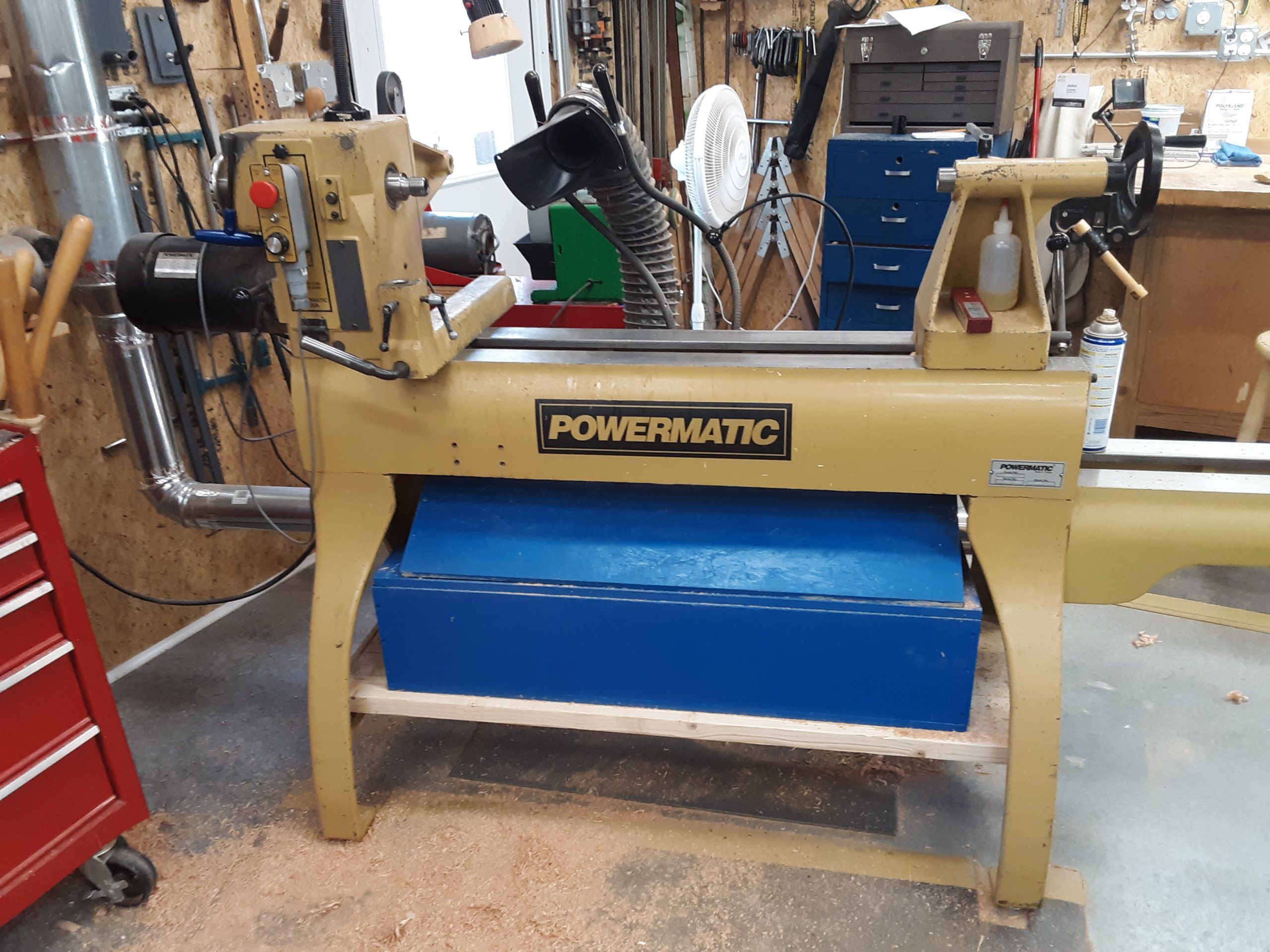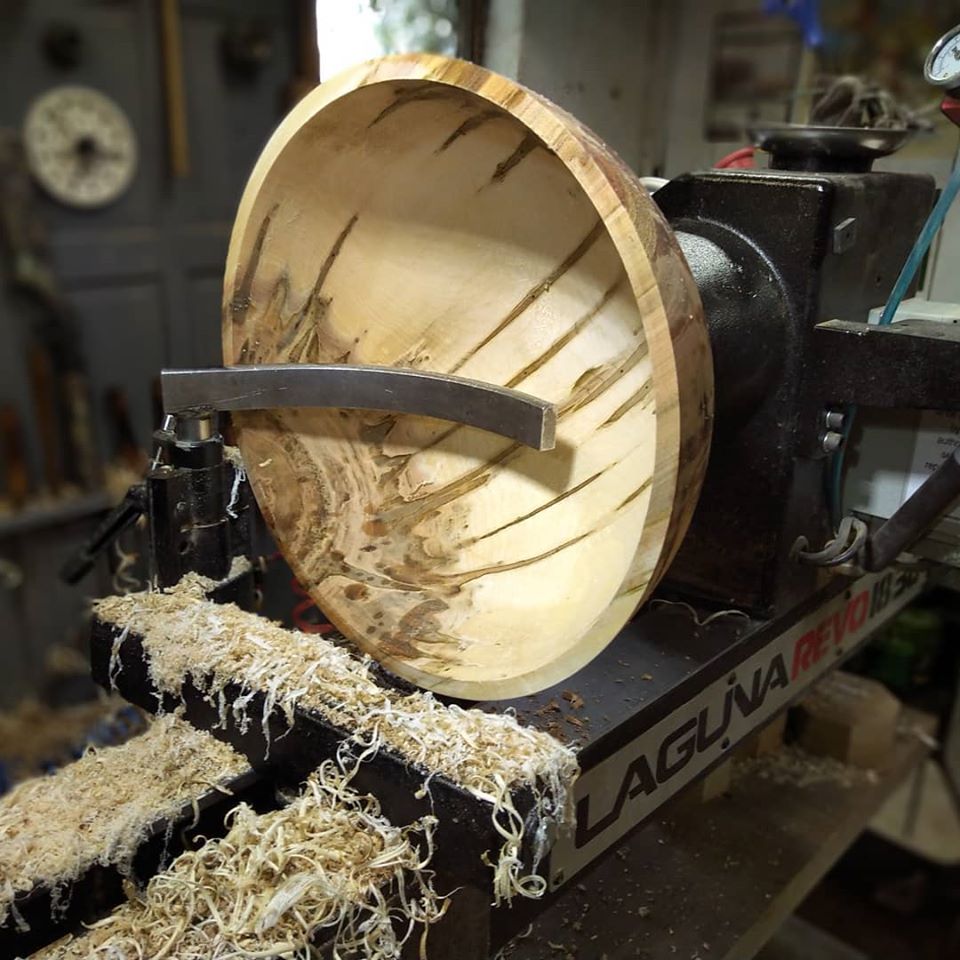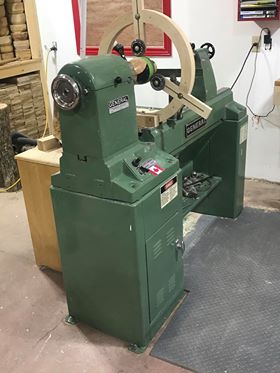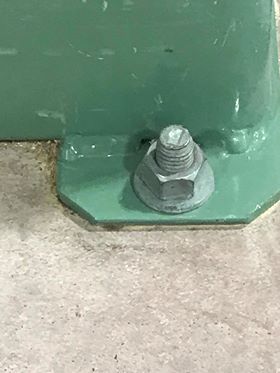
Photos by Multiple Sources
To fortify or not fortify my lathe: that is the question I often ponder. At one point or another most woodturners will push their lathe a bit, causing the lathe to shimmy and shake. When this happens, it not only raises safety concerns, but it also indicates that the lathe is under a good deal of stress that could potentially accelerate wear. There are varying opinions on how to best remedy this:
Add Weight
Many turners will add mass, such as bags of sand, to the lathe to provide some additional resistance to vibration. Most modern wood lathes provide some accommodation for this, like a location in the frame where a shelf can be placed to position some incremental ballast.
Bolt It to the Floor
Some turners take a more extreme approach and actually bolt their lathe down to the shop floor, delivering maximum stabilization if done properly.
No Fortification? Slow Down or Turn Something Else
Some woodturners believe their lathe is structurally designed to handle a specific load, and that any enhancement that allows the machine to spin additional mass is likely to place stress on the lathe that will accelerate its wear.
I believe there is no simple one-size-fits-all answer to the question of whether or not to fortify. All lathes are designed differently and can handle different loads. This inherently means there is no universal law about how much additional weight can be added, even as a percentage of overall lathe weight.
As a general rule, I operate my lathe without any additional weight. But on a couple occasions, when I was turning something that was at the upper limits of the lathe’s capacity, I added some weight. It definitely helped to stabilize the machine, particularly during the roughing stages.
Weight added to the bottom shelf helped a little. When I moved it up and set it on the bed itself, it helped a lot more. So I understand the benefits, but when I do this it makes me wonder about the additional strain that it would place on the lathe itself.
Experts Weigh In
Should the lathe’s shake and shimmy act as a governor, telling me I’m beyond the lathe’s capabilities? Or is it telling me to take action and stabilize the machine? That led me on a discovery quest to get perspectives from some serious wood turners, as well as lathe manufacturers.

Professional bowl turner Mark Stinson is known for turning massive 20” bowls (Ambrosia maple shown above) and avoids adding weight to his lathe.
“I think I have a different view on this topic than many,” he says. “While I agree that adding weight can help, I'm not convinced it's a good idea. A lathe's organic weight is based upon its construction. Thinner stock, possibly smaller spindle and bearings. So, if you force a lathe to remain more stable than it wants to be for the task, I believe, you risk stressing the integrity of the machine. This is only a theory of mine. But if you take a lathe that weighs 800# and a lathe the weighs 400#, adding 400# to the lighter lathe doesn’t make it as robust and durable as a lathe that weighs that total mass organically. You can bolt the thing to the core of the earth, but you may still be stressing the welds, spindle, bearings, bed, etc., and it will not eliminate the vibration that can occur between the bed and the sliding headstock, or the bed and the banjo.”
Avid wood turner John Lucas built a box for his Powermatic lathe that holds 250 pounds of pea gravel (pictured at the top of the article).
“I have always added ballast to my lathes,” he says. “I put the weight as low as I can. This setup works pretty well but then I don't turn a lot of big stuff. I turn a fair amount of smaller out of balance or off-center pieces and it helps quite a bit. I have every confidence that I’m operating within the lathe’s natural limitations, and that the added ballast simply stabilizes the tool and provides me with a better turning experience.”


For turners who might consider taking things a step further and bolting their lathe down to the floor, Canadian turner Lewis Golden shared his experience. His 20” swing General Lathe is bolted into 6” of mesh-enforced concrete using ½” x 5” galvanized wedge anchors (pictured above).
“I have roughed in pieces on the outboard that’s were larger than 20 inches in diameter,” Golden says. “The machine was built at the factory to be fastened down and I believe that there is no more solid fashion, (excluding modifying the machine), to limit movement than anchoring it using the factory drilled base. This has never presented any problems whatsoever and it has not been unbolted since I bought it new 21 years ago.”
I also spoke with a couple individuals who design lathes to get their perspective. Benjamin Helshoj, designer of the Revo Lathe series for Laguna Tools, says it’s a complicated, multi-variable question.
“We do not provide any specific guidelines to our lathe customers,” he says. “I believe that it is ok to add some weight to slightly extend the capabilities of a lathe, but there is a point at which it will mask problems and potentially cause damage to the machine. In that vein, I believe that bolting a lathe to a floor is potentially a bad idea, depending on the design of the machine, as it can muffle the lathe when it is trying to tell you something important. It would be like disabling a smoke detector that is sounding an alarm so that you can get back to sleep.”
Brent English, founder of Robust Tools LLC, weighed in as well.
“I think adding weight or bolting a lathe to the floor will certainly make the lathe more stable, and may improve the experience at the lathe for the turner,” English says. ”It’s important not to impart a twist on the lathe bed as that will negatively affect alignment. But I think if you’re adding weight and/or bolting the lathe to the floor to mitigate a weak or light weight lathe you may be setting yourself up for a false sense of security. If the lathe is shaking, that’s nature’s way of telling you to slow down and/or get things more balanced. The wood will fail before the lathe will, and failed wood flying off the lathe is not to be trifled with.”
Based on my own experience, and after getting input from several knowledgeable sources, I feel comfortable adding some weight to my lathes. I will occasionally add a couple sandbags, particularly when turning on a midi or midsized machine, but I rarely feel the need to do this on my 24” lathe.
Given some of the massive chunks of wood that I turn, weighing over 100 pounds in some cases, I wouldn’t feel comfortable bolting a lathe to the shop floor without first having a conversation with the manufacturer about the potential risks. If you are operating within the limitations and design of the lathe, then bolting it down might be an option, but with the “smoke alarm disabled” you are left to your own instincts as to what the lathe can handle.

Had a 14” Grizzly that had 150+/- lbs sand “permanently “ installed. Now have 20” Powermatic an no weight. If t starts to vibrate, I slow down speed or re-cut the wood being turned to make it more symmetrical
I started to turn a 16 inch green maple bowl today that was very imbalanced. The lathe vibrated drastically and the head end moved 18 away from me across the floor. Rather than add weight (it already weighs 500 lb) I will cut off the excess protrusion with an electric chain saw. Less stress on the berrings etc.
I am interested in the machine, Please send details.
I come from a CNC machine builders background. High precision CNC lathes sometimes have the base filled with concrete or similar. Wood lathes without a cast Iron base especially, will twist somewhat. The key is to take out the twist using leveling bolts at the floor and with high precision levels, checking that the ways of the Z axis slides are perfectly level along the entire length from the head to the tail stick. It takes a lot of tweaking on the leveling bolts but once there, and locked down to the floor, you’ll always be perfectly aligned because you took the twist out. This is way overkill for most woodworking but it’l keep Your lathe running true and steady. Vibration is your clue that something is wrong and spinning an unbalanced chunk of wood too fast is a setup for disaster.
I just finished bolting my lathe to the floor. I haven't had any bad vibration that made me do it. It's just a little bit bigger than my midi lathe. I think I did it because the stand It's mounted on doesn't look strong enough. I'm also adding a shelf to make sure that there isn't any twisting action going on. Hopefully, I could notice any problems even though it's bolted and fortified.
I am a fairly new turner since I retired. I was an aircraft engineer. In my experience vibration is never good unless tamping down concrete or sifting flour. My lathe is not weighted or bolted down. If it shakes about it is telling me something is out of balance. Then I go slower or shift centre or chop off a bit.
I was an avid woodworker many years ago and then became a Machine Designer/Mechanical Engineer (graduate of MIT). I have never designed a lathe. My 2 cents worth. The more stable you an make a machine the better. When things begin to vibrate a machine can tear itself apart however you need to remain vigilant to vibration. You should still be able to feel or see vibration when something is out of whack. Stop and do something different, forget this project, use different materials, slow down or get a different machine.
Bolt it to the floor if possible. Be sure to use shims to avoid twisting the bed.
Anytime there is vibration it’s telling you something is out of balance. It goes without saying you insure your lathe is level and vibration free when you first set it up. So when nothing is on the machine and no vibration it’s your object that’s causing it. I love the smoke detector logic! In my humble opinion adding weight or bolting to the floor is only masking the potential failure to take place. So when it’s starts to vibrate slow down and remove the excess material if it is out of round and if it’s still vibrating at higher speeds it’s time to make that critical decision is it worth it??
A lathe vibrates or even walks across the floor because of an out of balance piece being spun at a speed greater than the lathe can safely hold in the current mounting situation. Adding weight to the lathe or bolting it to a bench or floor will help with vibration without addressing the cause. Hand saws, band saws and chain saws are good tools for quickly removing the "non-round" parts rather than stressing the mounting methods, spindle bearings and other parts of the lathe. A piece that shakes the lathe and you probably isn't safe. Ask a friend with a larger lathe for help, or perhaps a local turning club has a bigger lathe. Few projects are worth getting injured. A shaking lathe is just asking for something to go wrong.